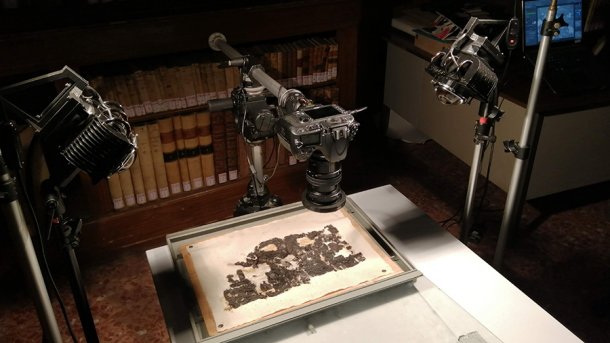Herculaneum Papyri: Imaging techniques decipher ancient writings about Plato
Using modern imaging techniques, Italian researchers have succeeded in deciphering millennia-old philosophical texts in charred scrolls.

(Bild: Universität Pisa)
An Italian research team was able to decipher around 1000 words (over 30 percent) of text from the charred ancient scrolls of Herculaneum using digital methods, as the team recently reported. The scrolls were buried under lava and ash during the eruption of Vesuvius in the year 79. The partially charred papyri were discovered during excavations in the 1750s.
The digital decoding of these writings is the task of the "GreekSchools" project, which is funded by the EU with 2.5 million euros and led by Prof. Graziano Ranocchia from the University of Pisa. The Italian Institute for Cultural Heritage Research (ISPC) and the Institute for Computational Linguistics "Antonio Zampolli" (ILC) of the National Research Council CNR as well as the National Library of Naples are also involved in deciphering the papyri.
State-of-the-art imaging methods
"GreekSchools is developing new methods to study the manuscripts by using state-of-the-art imaging techniques such as infrared/UV spectroscopy, molecular and elemental imaging, thermography, tomography and digital light microscopy," explains Dr. Costanza Miliani from the CNR Institute for Cultural Heritage Research. Using mobile devices from the Molab research platform, which is part of the European Research Infrastructure for Cultural Heritage E-RIHS, the scientists also examined double-sided and multi-layered papyri in order to make hidden texts visible.
The aim is to use imaging techniques and philological methods to create an updated edition of the "Survey of the Philosophers" by Philodemos of Gadaras. This work is the oldest surviving account of the history of Greek philosophy. The "History of the Academy" it contains contains valuable information on Plato and the development of his school under his successors. "The new edition has radically changed the text. It leads to a series of new facts about the Academy and its philosophers," says Prof. Ranocchia, explaining the significance of the discoveries. "Fragmentary passages could be supplemented or reinterpreted. The increase in text corresponds to the discovery of ten medium-sized papyrus fragments," adds Dr. Kilian Fleischer, the editor of the papyrus in the GreekSchools project.
New details from Plato's life
One of the most important pieces of news is that Plato was buried in a garden reserved for him at the Academy in Athens, near the so-called "Museion", a sanctuary dedicated to the Muses. Until now, it was only known that he was buried in the Academy, there were no more precise details about the location.
Plato was also apparently sold as a slave on Aegina as early as 404 BC when the Spartans conquered the island, possibly also in 399 BC after the death of Socrates. It was previously assumed that this had not happened until 387 BC in Sicily at the court of Dionysius I. Elsewhere, Plato makes disparaging remarks in a dialog about the musical abilities of a female musician from Thrace.
The progress of the research project, which will continue until 2026, gives reason to hope that the charred writings can be largely deciphered and reveal even more details of Plato's life.
"Vesuvius Challenge": particle accelerator and AI as a reading aid
Last year, as part of the "Vesuvius Challenge", some Greek letters and a first word in charred scrolls from Herculaneum were deciphered. An unusual approach was chosen for this. The two computer science students Luke Farritor from the University of Nebraska-Lincoln and Youssef Nader from Freie Universität Berlin had two previously unopened papyrus scrolls scanned with a particle accelerator in the hope that entire passages of text could be deciphered from the high-resolution images.
Independently of each other, they trained AI models to recognize texts in the high-resolution images. Both were able to identify a series of Greek letters and a first word. Nader even recognized four columns with more than six lines each on the papyrus. Farritor won 40,000 dollars with his faster solution, Nader received 10,000 dollars.
(vza)